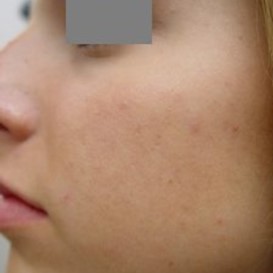Laser Acne Treatment
What is acne?
Acne is a very common skin condition that affects millions of people at ant given time and throughout most people’s lifetime.
It is characterised by spots on the surface of the skin, normally the face but also common on the back and chest. The spots can be identified as mild, ie surface blackheads or white-heads; or as severe, which are deep, inflamed pus filled cysts. It is the severe form of Acne that can lead to Acne scarring.
Acne may be caused by:
- Changes in hormone levels (which is why teenagers are very susceptible)
- Cyclical changes in hormone levels (menstrual cycle)
- Genetic links
- Pregnancy
- Cosmetic products
- Medications
What causes Acne?
Acne is caused the grease-producing glands next to hair follicles in the skin. The triggers above cause the glands to overproduce oil (abnormal sebum). It is the presence of this abnormal sebum that changes the activity of bacteria that is called P.acnes. This changes results in a more aggressive bacteria causing inflammation and pus.
Treatment of acne?
The treatment of Acne depends largely on the severity and on the individual. If the acne is presented in a mild form then over the counter gels and creams can be very effective but can still take months to clear.
If the symptoms are more severe then a range on antibiotics are available from your GP.
There is of course light based treatments for acne and acne scarring.
Laser treatment of Acne - How it works?
Once the pores have become blocked and colonised by the bacteria they thrive in the oxygen free environment that is now present at this part of the skin. The laser or intense pulsed light treatment is absorbed by the red spots that are on the surface of the skin and interacts with the bacteria. This interaction destroys the oxygen free environment and thus kills the bacteria. It also reduces the effect on the release of histamines which contribute to the intense red inflamed look that the spots of many acne sufferers have.
If you have picked your spots or squeezed them and depending on the severity of the acne it can also lead to acne scarring which will not be treated in the same way as the active acne above.
The laser procedure
Although it is true to say that light-based therapies are light-years ahead of other acne treatments, it is important that the patient takes care of their skin both before during and after treatment with an adequate skin hygiene regime.
Light-based treatment of the skin for acne treatment is very simple. The light source, be it laser, IPL or LED, is directed at the entire area of skin seen to have acne. The skin may feel warm and cold air may be used to make the treatment more soothing. Cooling is particularly important with laser and IPL, since these technologies generate excessive skin heating.
What laser to use?
There are a range of laser and intense pulse systems available on the market today for the treatment of acne, but which one works best? As discussed earlier, we need a laser that targets the red spots, so something that is highly absorbed by haemoglobin. Nd:YAG laser is one of the lasers in this category (see our article on Understanding Lasers.
The Nd:YAG will safely target the red spots so penetrating and destroying the bacteria successfully. The reason why we have chosen Nd:YAG is that it is safe to use on skin types for the treatment of Acne. Also it will penetrate deeply causing what is called neocollagenesis (stimulation of new collagen). This in effect will cause the skin to remodel and new collagen form increasing elasticity of the skin and the overall appearance. This also helps with the appearance of acne scarring. It builds up the collagen so the pits are not as deep.
Acne scarring
To treat scarring that can be left over from acne you really need a two pronged approach.
Non-ablative as with the Nd:YAG above, to stimulate the growth of new collagen which will help repair some of the damaged skin caused by the acne and improve the appearance
Ablative as with an Eerbium:YAG laser or indeed a CO2 laser. Our preferences is for Erbium:YAG as it is less aggressive and more controlled. This technique removes a small area of skin around the scar which stimulates a production of new skin and a smoother area over the scar.
Requirements for a successful treatment.
To help maintain an acne-free appearance once the laser treatment has finished, there are a few things to remember:
The skin will clear to its normal state after the bacteria is destroyed - this can take around 4-6 treatments, usually spaced about a week apart.
A good cleaning skin-care routine should be practised, but, to minimise scarring, the sufferer should avoid squeezing or picking at the acne
Resolution of Acne scarring can take many treatments and is only considered completed when the client achieves the look and result they require.
Latest Advances
LED technology for Acne treatment has seen a resurgence in recent months, and not without merit. Dedicated LED facial devices, such as the hugely popular OPERA, LED & Galvanic current, face-mask, now marketed in the UK through LED Aesthetics, have been shown to be highly successful in the treatment of Acne, as a result of the combined Bactericidal effect of 415nm visible light and 630nm infrared light.
Example Before and After Image
Acne - Prior to laser treatment

Acne - Following laser treatment regime

